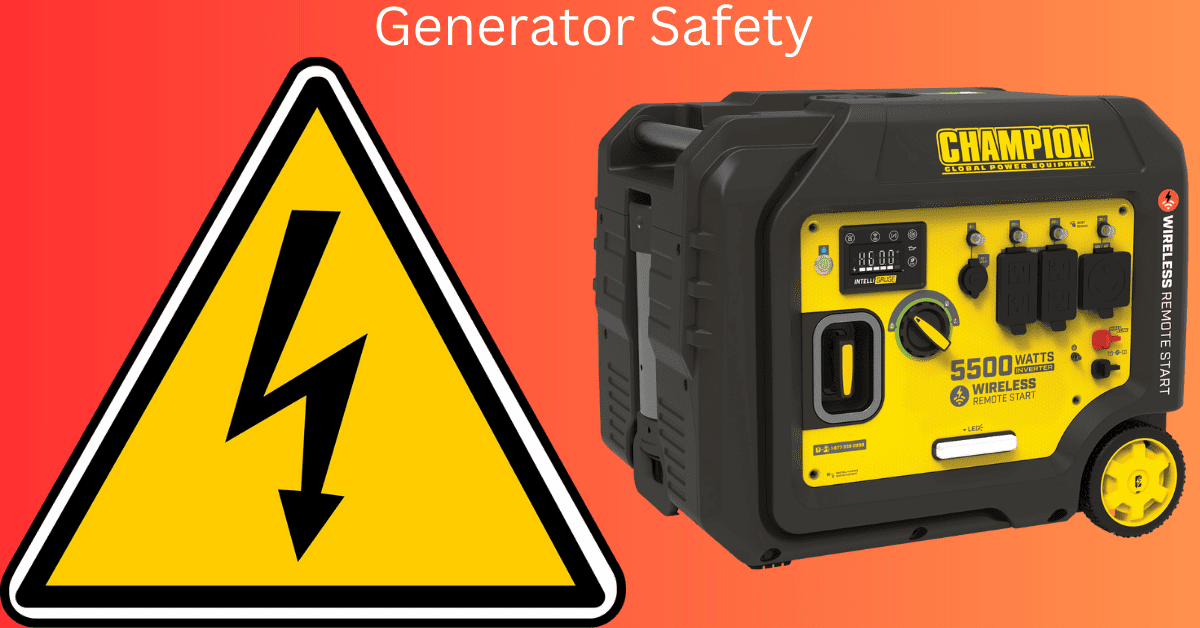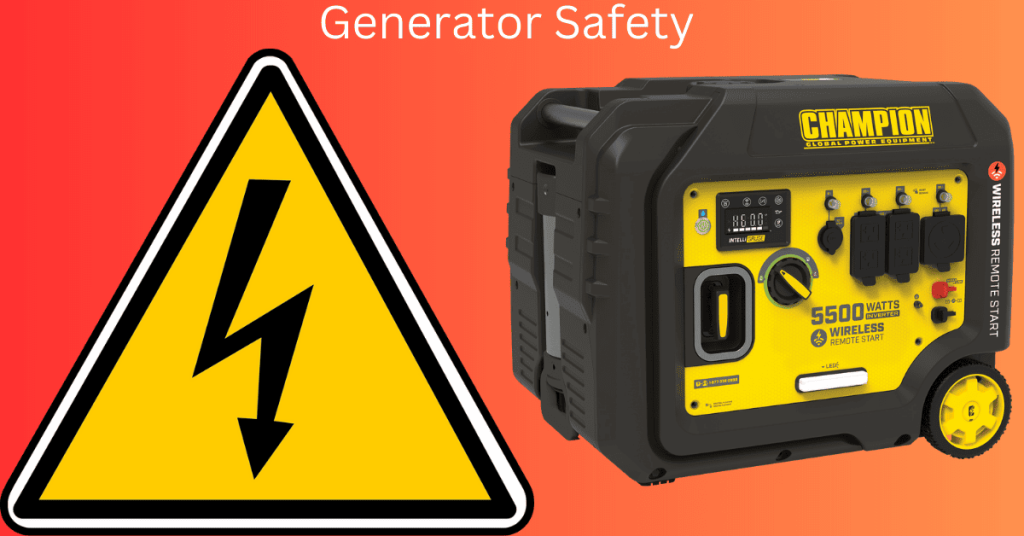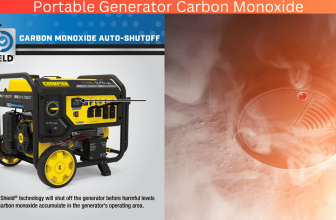
Are you ready to unleash some power? Portable generators can be a lifesaver during power outages or when you need electricity on the go. But before you fire up that generator, it’s important to make sure you’re using it safely and effectively.
In this article, we’ll share some tips to help you get the most out of your generator without putting yourself or others in danger. At first glance, portable generators might seem like simple machines, but there are a lot of factors to consider when using them.
Choosing the right generator for your needs, selecting a safe location, following proper start-up procedures, and avoiding backfeeding are just a few of the things you need to keep in mind. By paying attention to these details and practicing safe fuel handling and maintenance, you can unleash the full potential of your generator without any worries.
So let’s dive in and explore some tips for unleashing safe power with your portable generator.
Key Takeaways
- Choosing the right generator for your needs is crucial.
- Always place your generator outdoors, not in an enclosed space.
- Prioritize which appliances you absolutely need to run during a power outage.
- Proper fuel handling and regular maintenance and inspection are essential for safe and efficient portable generator usage.

Choose the Right Generator for Your Needs
You’ll want to make sure you choose the right generator for your needs so that you don’t end up with a machine that can’t keep up or is too powerful for what you need it for.
The first thing you need to consider is your power requirements. Calculate the total wattage you’ll need to power your essential appliances and tools during an outage. This will give you an idea of the minimum wattage you should look for in a generator.
Another thing to consider is the fuel type. Generators are typically powered by three types of fuel: gasoline, propane, or diesel. Gasoline is the most common, but it has a shorter shelf life and can be difficult to store for long periods of time. Propane and diesel, on the other hand, have longer shelf lives and are easier to store, but they may cost more upfront.
Once you’ve determined your power requirements and fuel type, you can start looking for generators that fit your needs. Keep in mind that portable generators come in different sizes and styles, so choose one that’s easy to transport and fits your budget.
Selecting the right generator is key to ensuring you have enough power for your needs, without overspending or underperforming. With the right generator, you’ll be ready to move onto the next step – selecting a safe location for your generator.
Select a Safe Location for Your Generator
When placing your generator, make sure to choose a location that is well-ventilated and away from any potential hazards. Here are some tips to help you select a safe location for your generator:
- Always place your generator outdoors, not in a garage, shed, or other enclosed space. This will help prevent carbon monoxide poisoning, which can be deadly.
- Make sure your generator is at least 20 feet away from your home and any other buildings. This will help prevent fires and other hazards.
- Choose a flat, dry surface for your generator. This will help prevent it from tipping over and causing damage or injury.
- If possible, place your generator on a concrete pad or other sturdy surface. This will help prevent it from sinking into the ground or being damaged by moisture.
By following these tips, you can help ensure that your generator is placed in a safe location. Once you have chosen a location, it’s important to follow proper start-up procedures to ensure that your generator operates safely and efficiently.
Follow Proper Start-Up Procedures
Before starting up our generator, we always make sure to read the manual thoroughly to understand the proper procedures. We also check the fuel and oil levels to ensure that the generator will run smoothly and efficiently. Additionally, we use a grounding rod to prevent any potential electrical hazards.
By following these key points, we can safely and effectively start up our generator.
Read the Manual
Once you’ve acquired a portable generator, it’s essential to familiarize yourself with its functions and specifications by carefully reading the manual. The manual is your ultimate guide to ensuring that your generator runs smoothly and efficiently.
Here are some tips that you can find in the manual that’ll help you unleash your generator’s safe power:
- Know the generator’s wattage and capacity to determine the appliances it can power.
- Follow the manufacturer’s recommended maintenance schedule to keep your generator in good condition.
- Learn how to connect your generator to your home’s electrical panel safely.
- Understand the safety precautions when using a generator to avoid accidents.
- Know the proper way to store your generator to prolong its lifespan.
By reading the manual, you’ll be able to maximize your portable generator’s potential and avoid costly mistakes.
Once you’ve familiarized yourself with the manual, the next step is to check fuel and oil levels before starting your generator.
Check Fuel and Oil Levels
To ensure your generator runs smoothly, make sure you check the fuel and oil levels regularly before starting it up. Without enough fuel, the generator won’t run at all, while insufficient oil can cause damage and shorten its lifespan. We recommend that you check the fuel and oil levels every time before starting your generator. It’s a simple check that takes just a few minutes and can help prevent costly damage.
Checking the fuel and oil levels is easy. First, make sure the generator is on a level surface. Then, locate the fuel and oil tanks, which are usually marked with clear labels. Check the fuel level by looking at the fuel gauge or by opening the fuel cap and visually inspecting the fuel level.
To check the oil level, remove the oil dipstick, wipe it clean, reinsert it, and then pull it out again. The oil level should be between the two marks on the dipstick. Once you have checked both levels, you can start your generator with confidence, knowing that it has the fuel and oil it needs to run efficiently.
Now, let’s move on to the next step and learn about grounding rods.
Use a Grounding Rod
If you don’t use a grounding rod, you could be setting yourself up for a potentially dangerous situation with your generator. When a generator is not grounded, it can cause an electrical shock or start a fire.
Here are a few things to keep in mind when using a grounding rod:
- Find a location where the grounding rod can be driven into the ground that’s close to your generator.
- Use a copper grounding rod that’s at least 4 feet long for best results.
- Connect the grounding rod to the generator using a heavy-duty copper wire.
By properly grounding your generator, you can ensure that you and your family are safe from any potential electrical hazards. This is just one of the many steps you can take to ensure you’re using your portable generator safely.
Now, let’s talk about how to avoid backfeeding when using your generator.
Avoid Backfeeding
Remember, never backfeed electricity into your home using a portable generator. This dangerous practice involves plugging the generator into a wall outlet, which causes electricity to flow the opposite way it was intended. This can put utility workers and your household at risk of electrocution and damage appliances or electronics that are connected.
Instead, use extension cords to connect appliances directly to the generator’s outlets. To avoid backfeeding, be sure to install a transfer switch. This device ensures that electricity flows only one way, from the generator to the appliances, and prevents it from flowing back into the power lines.
A licensed electrician can install a transfer switch for you, but make sure to check your local building codes to ensure compliance. By avoiding backfeeding, you can prevent damage to your home and keep you and your family safe.
However, it’s important to note that using extension cords can still pose a risk of overloading the generator. In the next section, we’ll discuss how to prevent overloading and ensure safe usage of your portable generator.
Prevent Overloading
Make sure you don’t load up your generator with too many appliances, as doing so is like putting too many toppings on a pizza and risking it falling apart. Overloading your generator can cause it to malfunction and even potentially start a fire. It’s important to know the wattage of each appliance you plan on running and to not go over the wattage capacity of your generator.
To prevent overloading, it’s a good idea to prioritize which appliances you absolutely need to run during a power outage. Keep in mind that certain appliances, like refrigerators and freezers, require more power to start up than they do to run continuously.
It’s also important to avoid plugging in extension cords or power strips to your generator, as this can overload the system as well.
In addition to preventing overloading, it’s important to practice safe fuel handling when using your portable generator. Always store fuel in an approved container and away from any potential sources of heat or flames. Refuel your generator when it’s turned off and cool to the touch, and never operate it in an enclosed space where carbon monoxide can build up.
By following these tips, you can safely and effectively use your portable generator during a power outage.
Practice Safe Fuel Handling
When handling fuel for your generator, always store it in an approved container that’s kept away from any potential sources of heat or flames. This is because fuel is highly flammable, and even a small spark could ignite it and cause a fire.
Additionally, make sure to label the container with the type of fuel it contains, as it can be dangerous to mix different types of fuel.
When refueling your generator, turn it off and let it cool down for at least 10 minutes before adding fuel. This is to prevent any hot surfaces from igniting the fuel. It’s also important to never add fuel while the generator is running, as this can be extremely dangerous.
Proper fuel handling is essential to ensure safe and effective generator usage. By following these guidelines, you can minimize the risk of accidents and keep your generator running smoothly.
Now, let’s move on to the next section about regular maintenance and inspection to keep your generator in top shape.
Regular Maintenance and Inspection
Now that we know the importance of practicing safe fuel handling when using portable generators, let’s talk about regular maintenance and inspection. Just like any other equipment, generators need to be maintained and inspected regularly to ensure they’re working properly and safely. Neglecting maintenance and inspection can lead to a variety of problems, including poor performance, safety hazards, and even costly repairs.
Here are three reasons why regular maintenance and inspection is crucial for safe and efficient portable generator usage:
- It prolongs the lifespan of the generator: Regular maintenance and inspection can help identify and address potential issues before they turn into major problems that require expensive repairs or replacement. By taking good care of your generator, you can extend its lifespan and ensure it continues to function properly for years to come.
- It ensures optimal performance: Just like a car, a generator needs regular tune-ups to ensure it’s running at peak performance. Regular maintenance and inspection can help identify any issues that may be affecting the generator’s performance, such as clogged air filters or dirty spark plugs, and address them accordingly.
- It promotes safety: Regular maintenance and inspection can help identify any potential safety hazards, such as damaged cords or leaking fuel lines, and address them before they cause harm. By taking good care of your generator, you can ensure that it’s a safe and reliable source of power during emergencies or outdoor activities.
Frequently Asked Questions
Can a portable generator be used indoors?
No, never use a portable generator indoors. Carbon monoxide poisoning is deadly, and it’s produced by the generator’s engine. In fact, 70% of generator-related deaths from 2005-2017 were due to carbon monoxide poisoning. Stay safe and only use generators outside.
What is the best way to store a portable generator when not in use?
To store a portable generator, we keep it in a dry, cool place with the fuel tank empty. We also remove the spark plug, clean it, and coat it with oil. Proper storage ensures our generator is always ready for use.
Are there any special safety precautions to follow when using a portable generator in wet conditions?
Yes, there are special safety precautions to follow when using a portable generator in wet conditions. We should always keep the generator dry, use a ground fault circuit interrupter (GFCI) and never operate it indoors or near open windows.
How long does a typical portable generator last before needing to be replaced?
Portable generators typically last for several years with proper maintenance and usage. Regular oil changes, fuel stabilizer, and occasional tune-ups can extend the life of the generator. It’s important to follow the manufacturer’s recommended maintenance schedule to ensure optimal performance and longevity.
Are there any government regulations or permits required for using a portable generator in residential areas?
No, there are no government regulations or permits required for using a portable generator in residential areas. According to a recent study, 70% of portable generator owners do not know that they should keep it at least 20 feet away from their home.
Conclusion
So there you have it, folks! These simple tips can help you unleash the safe power of your portable generator.
But wait, you might say, isn’t all of this too much work? It seems like a lot of hassle just to use a generator.
Well, I understand where you’re coming from. But let me ask you this: is your safety and the safety of your loved ones worth the extra effort?
Remember, a portable generator can be a lifesaver during power outages or emergencies. By following these tips, you can ensure that your generator is not only effective but also safe to use.
So go ahead and unleash the power of your generator, but do it the right way!





